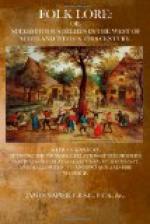Many other superstitious notions still exist among us with respect to certain animals, which have, no doubt, had their origin in remote times—some of them, doubtless, being survivals of ancient forms of animal worship. The ancient Egyptians worshipped animals, or held certain animals as symbols of divine powers. The Jews made a division of animals into clean and unclean, and the ancient Persians held certain animals in detestation as having a connection with the evil spirit; while others were esteemed by them as connected with the good spirit or principle. Other ancient nations held certain animals as more sacred than others, and these ideas still exist among us, modified and transformed to a greater or less extent. The robin is a familiar example of a bird which is held in veneration by the popular mind. The legend of the robins in the Babes in the Wood may have increased this veneration. There was a popular saying that the robin had a drop of God’s blood in its veins, and that therefore to kill or hurt it was a sin, and that some evil would befall anyone who did so, and, conversely, any kindness done to poor robin would be repaid in some fashion. Boys did not dare to harry a robin’s nest.
The yellow yite, or yellow hammer, was held in just the opposite estimation, and although one of the prettiest of birds, their nests were remorselessly harried, and their young often cruelly killed. When young, I was present at an act of this sort, and, as an illustration of courage and affection in the parent bird, I may relate the circumstance. The nest, with four fledglings, was about a quarter of a mile outside the village. It was carried through the village to a quarry, as far on the opposite side. The parent bird followed the boys, uttering a plaintive cry all the way. On reaching the quarry, the nest was laid on the ground, and a certain distance measured off, where the boys were to stand and throw stones at it. While this was being done, the parent bird flew to the nest, and made strenuous efforts to draw it away; and when the stones were thrown, it flew to a little distance, continuing its cry; and only flew away when it was made the mark for the stones. These boys would never have thought of doing the same thing to a nest of robins. It was said to have a drop of the devil’s blood in its veins, and that its jerky and unsteady flight was a consequence of this. The hatred to the yellow hammer, however, was only local. The swallow was also considered to have a drop of the deil’s blood in its veins; but, unlike the yellow hammer, instead of being persecuted, it was feared, and therefore let alone. If a swallow built its nest in a window-corner, it was regarded as a lucky omen, and the annoyance and filth arising therefrom was patiently borne with under the belief that such a presence brought luck and prosperity to the house. To tear down a swallow’s nest was looked upon as a daring of the fates, and




